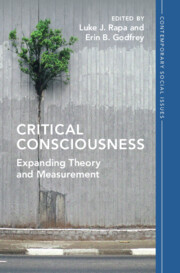Book contents
- Critical Consciousness
- Contemporary Social Issues
- Critical Consciousness
- Copyright page
- Dedication
- Contents
- Figures
- Tables
- Contributors
- Acknowledgments
- Introduction Critical Consciousness Theory and Measurement
- Part I Theory
- Part II Measurement
- 7 Critical Consciousness Measurement
- 8 Using Social Network Analysis to Identify Individual and Structural Precursors for Promoting Critical Consciousness in Childhood and Adolescence
- 9 Conceptualizing Adolescents’ Daily Critical Consciousness
- 10 Measurement and Analysis in Quantitative Critical Consciousness Research
- 11 The Development of the Contemporary Critical Consciousness Measure-Short
- Conclusion Expanding Critical Consciousness Theory and Measurement
- Index
- References
10 - Measurement and Analysis in Quantitative Critical Consciousness Research
Attending to the Complexities of Systems and Selves
from Part II - Measurement
Published online by Cambridge University Press: 20 April 2023
- Critical Consciousness
- Contemporary Social Issues
- Critical Consciousness
- Copyright page
- Dedication
- Contents
- Figures
- Tables
- Contributors
- Acknowledgments
- Introduction Critical Consciousness Theory and Measurement
- Part I Theory
- Part II Measurement
- 7 Critical Consciousness Measurement
- 8 Using Social Network Analysis to Identify Individual and Structural Precursors for Promoting Critical Consciousness in Childhood and Adolescence
- 9 Conceptualizing Adolescents’ Daily Critical Consciousness
- 10 Measurement and Analysis in Quantitative Critical Consciousness Research
- 11 The Development of the Contemporary Critical Consciousness Measure-Short
- Conclusion Expanding Critical Consciousness Theory and Measurement
- Index
- References
Summary
This chapter focuses on the complexities of systems and selves as they pertain to critical consciousness scholarship. By systems, we mean the multiple and intersecting systems of oppression that historically and currently operate in the United States and globally. By selves, we mean individuals’ understandings of themselves and their social locations. Our chapter in organized in three sections: (1) the complexity of systems, (2) the complexity of selves, and (3) the complexity of relationships between systems and selves. Within each section, we highlight several points about complexity, share some observations about how that complexity has been addressed within quantitative critical consciousness scholarship, and make practical recommendations for quantitative research specifically (and researchers across fields and methodological orientations more generally). We suggest that attending to these complexities will enhance scholarship and contribute to the knowledge base about how to promote socially just actions in different groups of young people and in different contexts.
Keywords
- Type
- Chapter
- Information
- Critical ConsciousnessExpanding Theory and Measurement, pp. 253 - 286Publisher: Cambridge University PressPrint publication year: 2023
References
- 2
- Cited by

